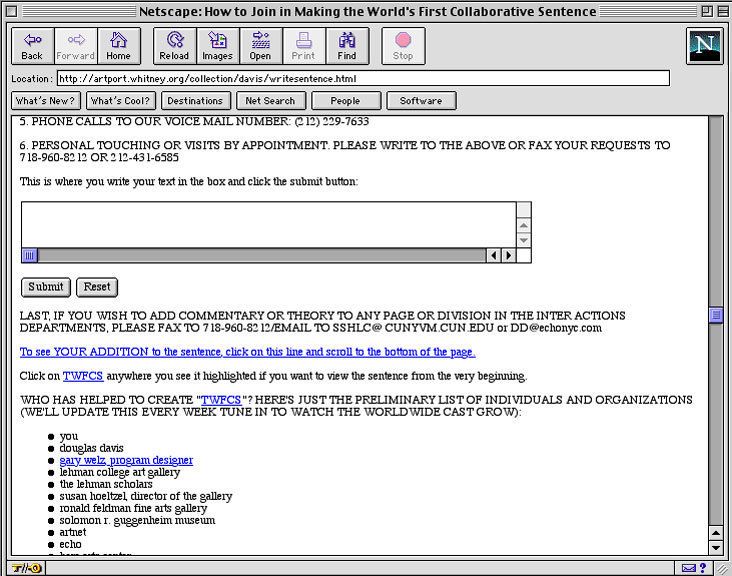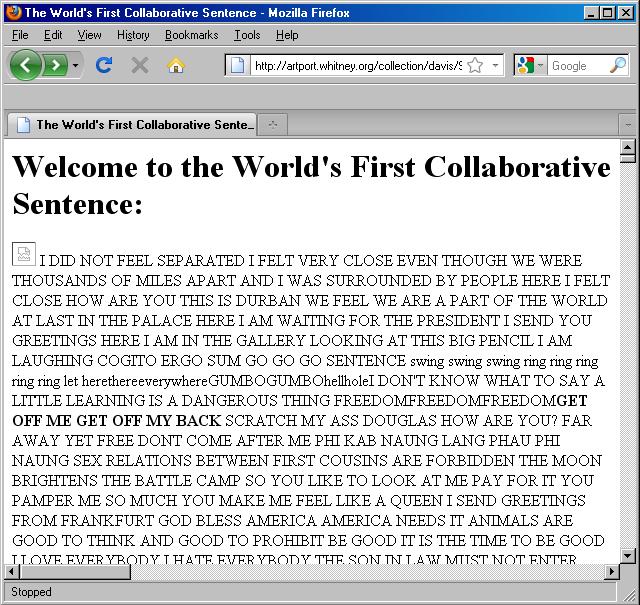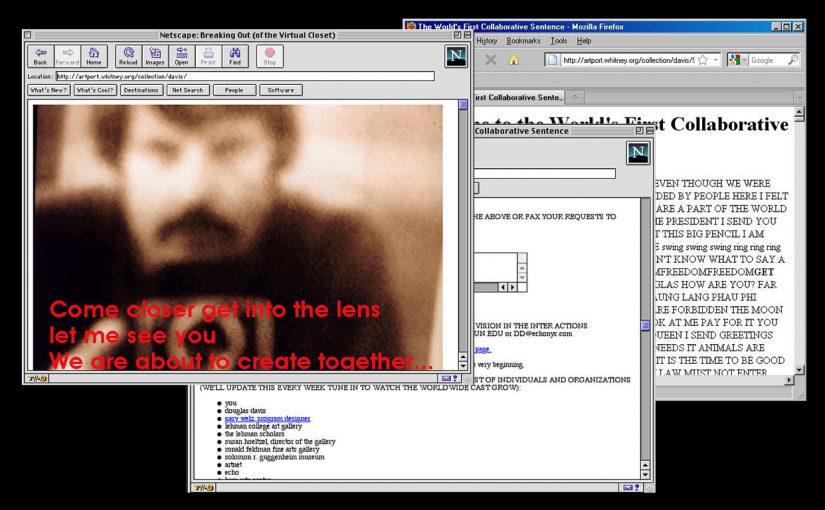The World’s Longest Collaborative Sentence
by Douglas Davis

Interactive websites have always been my interest and I would say Douglas Davis’ Collaborative Sentence live website was the most simplest form of interaction between people over the World Wide Web. Nowadays, web designers and developers put so much thought into building a website which has outstanding interactive elements accompanied by beautiful graphics. However, Collaborative Sentence had shown that the most basic website with a clear concept and goal will always be remembered.
Since the piece was created during the time when WWW was established, people were intrigued by the function of it. It allowed users to contribute words into the never-ending sentence which formed the possibility of today’s trend of blogging where new material is added regularly to update a blog. Davis had engaged modern art and modern media into something that could be experienced together by people all over the world.

The first few words that started this piece basically summarised what it was all about, “I did not feel separated I felt very close even though we are thousands of miles apart and I was surrounded by people here I felt close…”. Strangers came together without knowing the other person’s culture and background (probably only by the language that they used), contributed some words and produced a collaborated piece as a whole. The content produced were not seen as something judgemental anymore instead, it was seen as a form of art.
The Restoration
All physical works of art are slowly affected and degraded by natural elements. This is the moment where art restorers step in to fix the flaws using similar materials as close to the original work as possible. However, it is difficult to restore an art which is computerised.
Softwares get updated over the years and it is almost impossible to parallel an old software using our advanced technology. As a result, the piece changed from its original form.
“We’re working on constantly shifting grounds. Whatever hardware, platform or device we’re using is not going to be there tomorrow.”
Rudolf Frieling, a curator of media arts at the San Francisco Museum of Modern Art
Then came the consideration whether Davis’ Collaborative Sentence should be fixed or should it remain unchanged in respect to its authenticity. By creating two versions of the piece (presented in both original and updated forms), we could see how there are still flaws in today’s ‘advanced’ technology to restore something that looked ‘simple’.
“..from this brief investigation that even a seemingly simple technology-based artwork can go very,very wrong when it is not properly cared for, or when parts of the work are not collected at all.”
Michael Conner, writer of the “Restoring the ‘The World’s First Collaborative Sentence’” article
In Conclusion
With new digital art being created ever more rapidly, for how long can we continue maintaining this piece?
The World’s Longest Collaborative Sentence is still a valuable piece as it is a “harbinger of the future”, as quoted by Christiane Paul, an adjunct curator of New Media Arts at the Whitney Museum of American Art. By allowing interaction across cultures and countries over the Internet, the piece anticipated so much of what happened in today’s Web 2.0.
As part of the new generation of Web-based creators, this piece is an eye-opener for me to realise that 80-100 years down the road, will the users of Web 15.0 (who knows how fast the evolution of technology will be) be able to see and appreciate our online works?
References
http://rhizome.org/editorial/2013/jun/12/restoring-douglas-davis-collaborative-sentence/
http://whitney.org/Exhibitions/Artport/DouglasDavis
http://www.medienkunstnetz.de/works/the-worlds-first-collaborative-sentence/

Excellent! I was particularly struck by your comment about strangers coming together in a collaborative work of art. Now, that seems like an oxymoron, how can you collaborate with strangers, and those who are distributed all over the world? Douglas Davis’ World’s Longest Collaborative Sentence demonstrated just how that was possible. My linking strangers together in the act of co-authoring a continuous, non-stop sentence, he brought those people together, linked them through his artistic project. That is the strength of the Web in the hands of artists, like Hole in Space, to bring people together who don’t necessarily know each other and invite them to engage in social interaction.